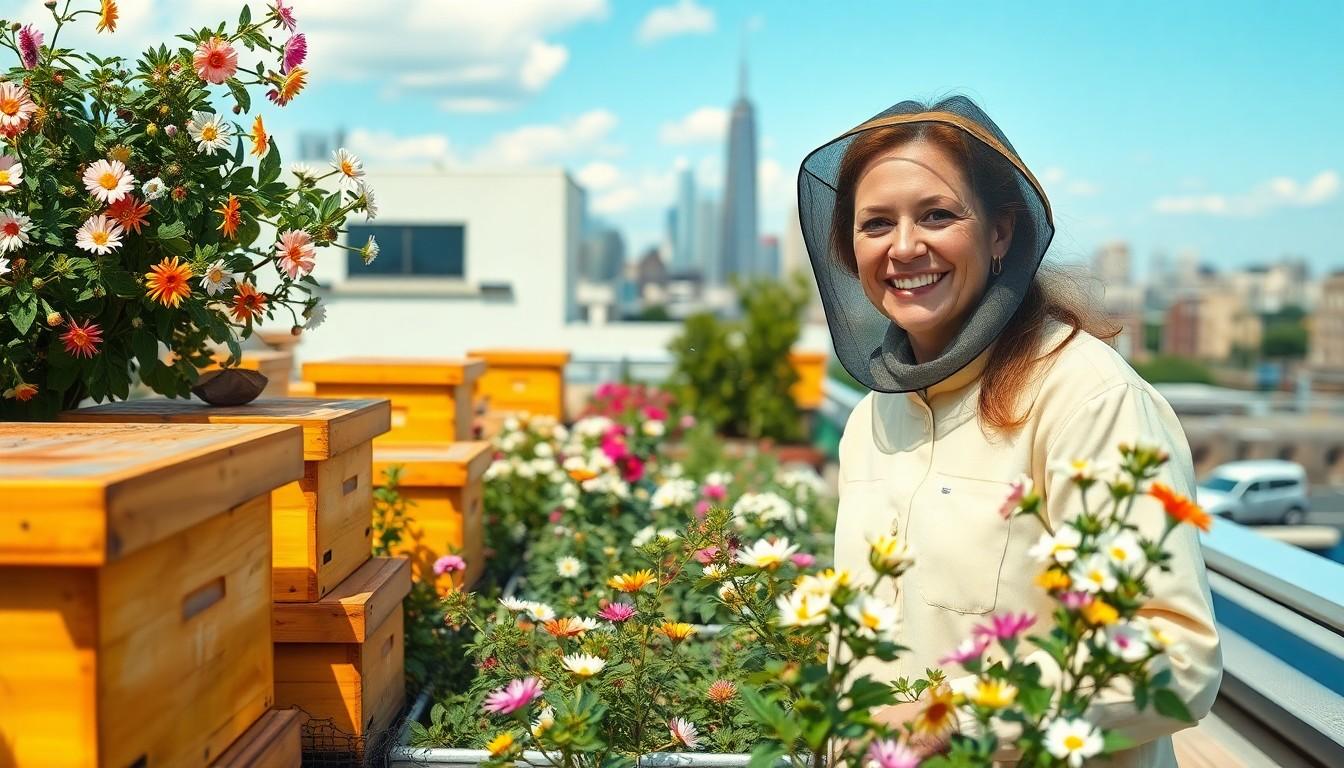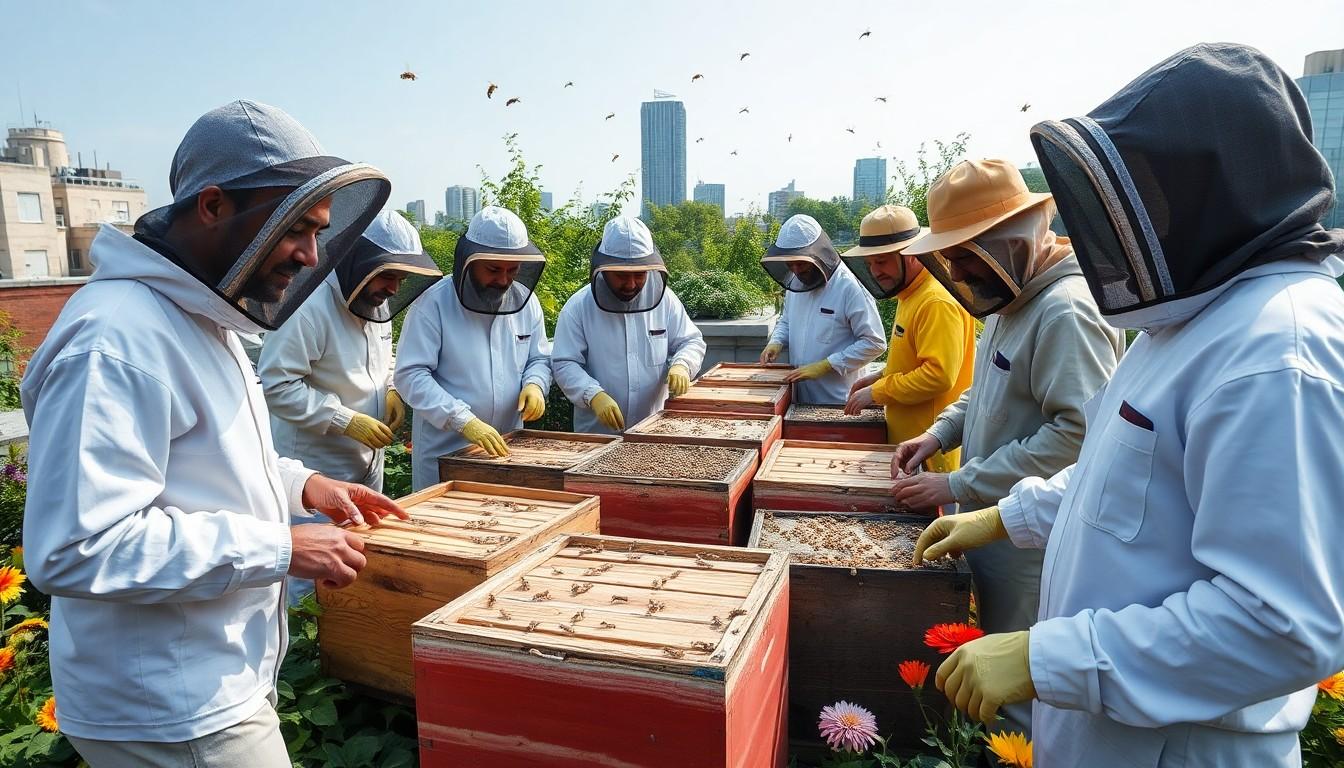The Best Fluffy Pancakes recipe you will fall in love with. Full of tips and tricks to help you make the best pancakes.

Urban Beekeeping: Transform Your City into a Buzzing Eco-Friendly Haven
In a world where concrete jungles reign supreme, urban beekeeping is buzzing onto the scene, proving that even the busiest city can host a hive of activity. Picture this: a rooftop garden, bees flitting about, and the sweet aroma of fresh honey wafting through the air. It’s not just a quirky hobby; it’s a sustainable movement that’s turning city dwellers into eco-warriors, one bee at a time.
Urban Beekeeping
Urban beekeeping involves the practice of maintaining bee colonies in urban areas, often on rooftops, balconies, or community gardens. This trend promotes sustainability and enhances local ecosystems by increasing pollinator populations. Many city dwellers engage in urban beekeeping to produce honey, support biodiversity, and contribute to greener urban spaces.
The practice offers benefits, including access to fresh honey, educational opportunities, and improved air quality. Studies show that urban beekeeping can significantly impact city environments by helping to pollinate neighborhood plants. Enthusiasts often connect with local beekeeping associations for support and resources.
Understanding local regulations is essential for successful urban beekeeping. Types of permitted activities vary by city, so beekeepers need to familiarize themselves with guidelines. Equipment such as hives, protective gear, and tools like smokers are necessary for maintaining healthy colonies.
Community engagement plays a crucial role in this movement. Urban beekeepers frequently collaborate with local farmers, gardeners, and schools to elevate awareness of pollinator importance. Workshops and events help spread knowledge, allowing more people to participate in beekeeping practices.
Urban beekeeping transforms city landscapes into vibrant ecosystems. This practice not only beautifies urban settings but also fosters a sustainable future. Through collective efforts, urban beekeepers cultivate stronger connections to nature, making their cities greener and more resilient.
Benefits of Urban Beekeeping

Urban beekeeping offers multiple advantages for city environments. These benefits extend beyond honey production and encompass significant ecological contributions.
Environmental Impact
Urban beekeeping enhances local ecosystems by supporting pollinator populations. Increased pollination leads to improved plant growth and diversity. Research shows that bees can increase yields in urban gardens by up to 30%. City gardens flourish as a result, attracting a range of wildlife. Improved air quality is another critical benefit, as plants contribute to cleaner urban air through carbon dioxide absorption. Educational efforts within urban beekeeping initiatives raise awareness about environmental issues. Overall, these practices create more resilient cities with healthier ecosystems.
Contribution to Local Food Systems
Urban beekeeping plays an essential role in local food systems. By producing honey, urban beekeepers contribute directly to food security. Locally sourced honey boasts higher freshness and quality compared to store-bought options. Pollination services provided by bees also benefit fruit and vegetable production. Increased availability of local produce supports community health and reduces dependency on imports. Collaborations between urban beekeepers and local farmers further strengthen connections within the food network. Engaging in urban beekeeping fosters a deeper understanding of food sources among city residents.
Challenges of Urban Beekeeping
Urban beekeeping faces several challenges that beekeepers must navigate.
Regulation and Legal Considerations
Local regulations significantly impact urban beekeeping practices. Many cities have specific guidelines that establish hive limits, distance from property lines, and required permits. Beekeepers must research and comply with these regulations to avoid fines or hive removal. Some municipalities prohibit beekeeping altogether, while others encourage it through educational programs. Understanding local laws enhances the likelihood of successful beekeeping, ensuring that hives coexist harmoniously within residential areas.
Space Limitations and Hive Management
Space limitations present a challenge for urban beekeepers. Cities often lack adequate room for large apiaries, forcing beekeepers to work with smaller spaces like rooftops or balconies. Hive management in confined areas requires careful planning and must prioritize bee health. Effective management includes regular hive inspections, disease monitoring, and providing adequate food sources. Urban environments may also present obstacles, like limited foraging options which can affect colony strength. This makes attention to environmental factors critical for thriving urban bee populations.
Getting Started with Urban Beekeeping
Urban beekeeping requires careful planning and resource selection. Selecting the right location and equipment is essential for success.
Selecting the Right Location
Locations significantly influence bee productivity and health. Choose a spot with ample sunlight, at least six hours daily, which helps maintain hive activity. Accessibility matters, especially for routine inspections and honey harvesting. Consider proximity to blooming plants, as these provide vital food sources for bees. Noise levels should also be minimal, as loud environments may stress bee colonies. Local regulations can dictate suitable spaces, necessitating thorough research before establishing hives. Evaluate potential sites for nearby water sources, which bees need for hydration and temperature regulation in the hive.
Choosing the Right Equipment
Selecting quality equipment ensures a successful beekeeping experience. Start with the essential components, including hives, protective clothing, and tools. A standard Langstroth hive, composed of stacked boxes, allows for easy honey extraction. Essential tools include a smoker, which calms bees during inspections, and a hive tool for managing frames. Protective clothing, such as a beekeeping suit and gloves, provides safety during hive visits. Beginners may find packaged bees or nucleus colonies ideal for establishing their first hives. Investing in monitoring equipment, like hive scales or thermometers, can offer valuable insights into colony health and production. Choose equipment that suits the local environment and personal beekeeping goals.
Best Practices for Urban Beekeepers
Selecting the right location for hives plays a critical role in urban beekeeping success. Urban beekeepers should look for areas that receive at least six hours of sunlight daily. Ensuring accessibility simplifies inspections and management tasks for beekeepers. Proximity to blooming plants guarantees a reliable food source for the bees.
Monitoring hive health demands regular inspections for disease and pest management. Keeping bee populations healthy enables maximum production and resilience. Understanding local regulations prevents potential fines or hive removal, as compliance with city-specific guidelines protects beekeepers.
Maintaining equipment is essential for effective hive management. Quality hives and tools significantly impact the overall success of urban beekeeping. Beginners often find Langstroth hives easy to work with, making honey extraction straightforward. Investing in protective clothing helps minimize the risk of stings and fosters confidence while working with bees.
Incorporating community engagement amplifies the benefits of urban beekeeping. Collaborating with local farmers and gardeners strengthens the bond between beekeepers and their neighborhoods. Organizing workshops fosters awareness about the importance of pollinators, creating a well-informed community.
Patience is crucial in beekeeping, as establishing healthy colonies takes time. Beekeepers should expect fluctuations in colony strength, especially in urban environments. Emphasizing sustainable practices contributes to a greener city while impacting local ecosystems positively.
Lastly, documenting hive activity supports ongoing learning and improvement. Keeping a journal of observations allows beekeepers to identify patterns and adapt techniques accordingly. By following these best practices, urban beekeepers can maximize their impact on the environment while cultivating thriving bee colonies.
Urban Beekeeping will Increase
Urban beekeeping stands as a testament to the innovative spirit of city dwellers. By transforming rooftops and balconies into thriving habitats for bees, individuals contribute to a more sustainable and eco-friendly urban landscape. This practice not only enhances biodiversity but also fosters community connections and awareness about the vital role of pollinators.
As cities continue to grow, the importance of urban beekeeping will only increase. Embracing this movement can lead to healthier ecosystems and improved air quality. With careful planning and community collaboration, urban beekeepers can make a significant impact, ensuring that their cities are not just concrete jungles but vibrant ecosystems where nature and urban life coexist harmoniously.
